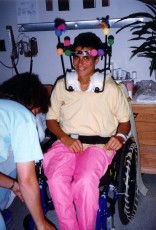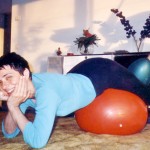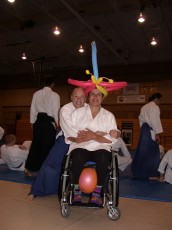Back in 1990, there was a film released entitled “Dancing with Wolves”. The title refers to the Native American name given to Lt. John Dunbar by a tribe of Sioux after they observed him playing with a young wolf.
In 1996, I was bestowed the name of “Woman with Balls” by a Jesuit priest, Father Miguel, during a week long Aikido retreat in San Rafael, California. Many people at camp were choosing “Native American” names that week, part tongue-in-cheek and part serious. My handle was given to me and, of course, there is a back story.
My damaged spinal cord, impacted at the C5-6 level in 1995, caused a lot of spasticity, involuntary movement that brought my body into a fetal position. The rattling of a newspaper, a quick movement, any unexpected stimulus would be totally misunderstood through the mind-body connection and uncontrolled motion would contract my muscles. My preference for zero mainstream pharmaceutical intervention led me to find ways to tame and address this spasticity. And this is where balls played an important role, both the emotional balls as in “Wow, that person sure has a lot of balls to take on that situation” and actual physical balls.
The attitude present in me, this Woman with Balls, served/serves me well as I live my life through the physicality of quadriplegia. And then, there are the myriad of balls of different sizes and composition that I have used and continue to use to enable my entire body to have the best possible movement integration and outcome.
The first balls entered my life about three weeks post injury. In order to stabilize my neck so the bones could heal, I wore a medical device called a halo. The halo was screwed into my skull in four places and a series of metal stabilizing rods attached to “body armor” kept me from moving my head in any direction. The metal rods had blunt ends that stuck up beyond the ring screwed to my skull. One day as I was being transferred to a wheelchair from the hospital bed, the nurse began to lose control of my body. At this point in my recovery, I could only shrug my shoulders so I was absolutely zero help in stabilizing my body as I plummeted to the floor. The nurse did the only thing he could do to keep me from landing on the floor. He blocked me with his entire body, impaling himself on the blunt ends of the halo. Ouch! My solution oriented, engineering mind searched for a way to eliminate the danger from the protruding shafts. My friend, Patrick, went off to a pet store, purchased soft, brightly colored toy balls with feathers that cats play with, drilled the perfect sized holes and fitted each shaft with a ball. I looked like I had planets circling around my halo.
The balls served a specific purpose, safety, and they also created quite a lot of laughter and conversation. I was being rolled down a hospital hallway one afternoon and a man and his wife stopped me to talk about the “look”. He spoke to his wife and said, “Wow, I wish you had decorated my halo like that.” The decorations definitely removed the Spanish Inquisition look of the entire device.
On early morning rounds towards the end of my hospital stay, my doctor and a nurse strolled into the room for their usual morning consultation and both noticed I was missing a couple of balls. What came next was a total surprise and delightful. Here were my physician, a very serious man, and my nurse searching around the bed and the floor until they recovered my balls and had them safely returned to my halo. They both seemed satisfied that everything was in place and continued with their original purpose. I had a deep smile inside, as it was a point of lightness in our communication. Those balls traveled with me for the entire three months I wore the halo and somewhere in the archives of the Stanford Health Library is a photo of my halo décor and me.

The next balls that entered my life were tennis balls. I used them in a variety of different ways. First I used them to encourage the structure of my hands to be normalized. There is a specific response that hands develops when quadriplegia is present and the form the fingers take make them virtually useless. I was determined I was going to avoid the dreaded “quad hand” if possible. Besides working with my hands throughout the day with massage, manipulation and some Aikido stretches, I prepared them at night for sleeping. I needed three items: a pair of tube socks, a Velcro wrist support and a tennis ball. I took a pair of large sized tube socks and put a tennis ball in each sock. I put one hand inside the sock and manipulated my fingers to wrap them around the ball until the roundness of the ball was pressing into my palm. Then, pulling the toes of the sock towards my wrist with my teeth, I was able to hold the length of fabric at my wrist and again, with my teeth, tighten the wrist support to hold it all together. Getting the second hand into the sock and creating the same positioning was challenging, but doable. The mouth is a handy feature when the hands are compromised. The effect I was looking for with this solution was successful. When my hands would spasm in a contracted form, the ball was there for squeezing, giving correct input. When my fingers would extend in a spasm, the sock kept my hand rounded. The tension on the sock also made it difficult for the spasms to force my wrists to flex backwards. The muscles, tendons and ligaments in my hands and wrist remained flexible and significantly functional.
I used a second pair tennis balls inside a sock to keep the muscles in my neck soft and responsive. During the surgeries that were performed to stabilize my neck, significant trauma was introduced into the bones of my neck and the muscular structures. There was a great tightness that was uncomfortable. I took two tennis balls and put them inside a sock that I then tied. While lying down on my back, I placed the balls at the base of my skull where the occipital bones are. I just relaxed and sent breath to the area and gradually the muscles relaxed. I still use this today to relieve any tensions that builds up in my neck.
The spasms that were present in my hands were also problematic for my legs. Fairly uncomfortable, my legs would squeeze together intensely and my heels would seek the comfort of my butt. This led me to find another type of ball, a Gertie ball that I found at my local toy store. The Gertie ball is made of a soft, skin like material that can be inflated to about 9”. They come in a variety of colors and patterns. I had about a dozen of these Gertie balls and whether I was sitting or lying down, I placed them in between my thighs, my knees, my calves and my ankles. When my spasticity kicked in squeezing the balls tightly, the balls would respond by pressing my legs back out. It was a bit like having hands relaxing and manipulating the muscles. The texture of the balls made it easy to keep them in place. Also, because they are inflatable, it was really easy to take them with me when I traveled. Another benefit I discovered was while sitting, the ball between my thighs made a great stable lap to rest things, making wheeling and carrying something much simpler and more stable.
Traveling to Hawaii with my family, I visited a home of a body worker. She had over a hundred of the Gertie balls in an area on the floor. I lay down on the floor and she placed the balls under my body, including all of my limbs. It was a most pleasant experience of supported weightlessness. My family members took a turn in this playpen of balls and found it to their liking as well. This is a very creative use of a simple child’s toy. In the storage redesign of our home, we have included a place for inflated Gertie balls.
Gym balls are a great asset to anyone, whether or not there is a rehabilitation issue. With a variety of sizes, it was easy to get creative with their use. I used to spend a lot of time on a carpeted floor, mimicking the way babies learn to rollover and then to crawl. Once I was able to get on my hands and knees, I found the smaller sized gym ball, tucked under my belly, gave my arms a rest. I just lay over the ball, enabling me to remain in the crawling position and move my arms and legs in a more free and functional way. As my arms became stronger, I would roll on the ball until it rested under my pelvis. This let my legs extend as straight out as they would go. The weight of my legs, extended, began to gradually stretch my calf muscles and my hamstrings, releasing the tightness and shortening that had developed.

Molly using an exercise ball in 1999 to help stretch her muscles.
Gradually, as I continued to get more movement in my body, I began to use the next larger gym ball, a blue one. I was doing much of the same movements I was doing on the orange ball, but I was much higher up off the floor. This, seemingly precarious position, stimulated my body’s memory of balance. The roundness of the ball made the core of my body, those muscles radiating out from the spine in my trunk, have to engage. As the ball rolled forward, backwards and sideways in many directions seemingly with a mind of it’s own, my muscle memory responded and continued to evolve in support of balance. Sometimes I rolled right off the ball onto the floor, but I made sure I had plenty of room so I didn’t get injured. Probably, the eleven years I had been training in a martial art that requires an adept falling and rolling practice removed a lot of the fear of falling.
Another benefit of rolling around on a gym ball was the digestive system massage that I received. I had been told I would have to use a bowel suppository and digital stimulation for the rest of my life in order to have a bowel movement. I was determined I was going to eliminate on my own. I started with proper nutrition, the vegetables, fruits, grains and such and massaged my belly everyday. I didn’t panic if I missed a day or two or even three without a bowel movement. Rolling around on the ball did a better job of massaging my intestines into function. It was a great tool that proved to be the perfect stimulation for recovery.
One of the healing activities I was able to find was Hippotherapy, the use of the horse for stimulating movement and memory. I found straddling the horse to be one of many benefits from this therapy. Most babies, most children who thrive are carried. Many times, the position their bodies are in have their legs wrapped around a hip or when carried on the shoulders their legs are wrapped around the neck. This position stimulates their inner thighs, the calves, and the pelvic floor. The straddle position with movement requires a child to engage their core muscles to maintain balance and an upright posture. The rocking motion also stimulates the hormone oxytocin, the feel good hormone, to be released into the body. After trying this straddle position on some of my big friends backs and finding my legs with their spasticity was crushing their ribs I looked for another solution. The closest I could come to repeating this straddle position at home was the use of a gym ball in the shape of a peanut. Since the peanut shape only rolls side-to-side and in a diagonal motion, I was able to stabilize myself on the ball with a couch on one side and a chair on the other. At first, I needed help to get on the ball. Eventually I was able to get on it by myself. It is as great a position for an adult as it is for a child with all the same benefits, core strength, balance, and the stimulation of the inner thighs, calves, and pelvic floor. With my feet on the floor, I use my legs for a jumping-type motion.
Coming back to my hands, I found the introduction of two other types of balls to be of benefit. I work with my hands daily, continuing to encourage as much functional recovery as possible. The signals our nerves produce are electrical in nature. One of the conduits for the movement of electricity in the world is wire made from copper. Copper carries electricity easily. I purchased a set of 1-1/2” copper balls in order to magnify the electrical signals in my fingers. I had to have the copper balls polished, as they were a bit rough on the exterior, but once they were smoothed; they became comfortable to work with. I place the copper balls in my palm and do a series of exercises with the support of my other hand, rolling the balls through the palm and over and around each finger. As I imagine in my mind the bending movement of the end of my finger, I have contact with the copper ball. I have fairly decent hand and finger movement and even these many years later I am finding more responsiveness.
I use both a manual wheelchair and a power wheelchair for my mobility. The power wheelchair has a joystick that is manipulated to power the chairs movements. The joystick is sticklike in shape and very uncomfortable to use. What I have done is mount a medium firm sponge ball on the joystick. This allows my hand to have a comfortable, fully contactual connection to the movement of my powerchair. My hand and fingers never get tired or cramped as the ball fits naturally in my palm. I highly recommend this addition to the joystick for anyone. I notice that many wheelchair companies now have this ball-shaped joystick as an option.
And finally folks, balls, the real human balls or testicles that are standard equipment on males. One of the delicate conversations that I recommend be considered primary in speaking with males who have spinal injuries, whether it results in paraplegia or quadreplegia, is the tendency to ignore this aspect of their anatomy. The conversation is something like “Well, I don’t have sensation or feeling there and have no erectile function (not always the case of course) so why would I bother?” The brain may not register the touching, but the body, below the mind does have sensation. Guaranteed that if any part of the body is ignored, there is little possibility of regaining function or sensation. It is important to remind the body, to give the body a point of location for memory to kick in. Wrapping ones mind around the idea of a useless appendage does nothing to stimulate connection.
